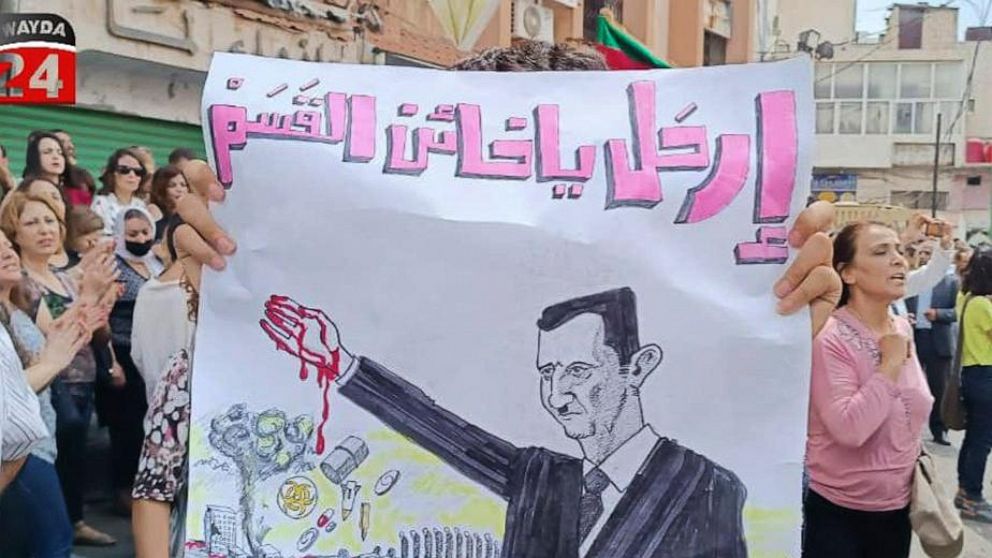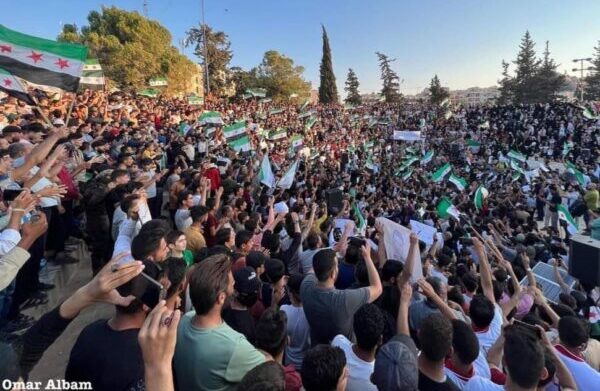
BEIRUT — Anti-government protests in southern Syria have stretched into a second week, with demonstrators waving the colorful flag of the minority Druze community, burning banners of President Bashar Assad’s government and at one point raiding several offices of his ruling party.
The protests were initially driven by surging inflation and the war-torn country’s spiraling economy but quickly shifted focus, with marchers calling for the fall of the Assad government.
The demonstrations have been centered in the government-controlled province of Sweida, the heartland of Syria’s Druze, who had largely stayed on the sidelines during the long-running conflict between Assad and those trying to topple him.
In a scene that once would have been unthinkable in the Druze stronghold, protesters kicked members of Assad’s Baath party out of some of their offices, welded the doors shut and spray-painted anti-government slogans on the walls.
Anger is building, even among Syrians who did not join the initial anti-Assad protests in 2011. Those demonstrations were met with a harsh crackdown and plunged the country into years of civil war.
For some, the final straw came two weeks ago when the Syrian president further scaled back the country’s expensive fuel and gasoline subsidy program. Assad also doubled meager public sector wages and pensions, but those actions did little to cushion the blow, instead accelerating inflation and further weakening the already sinking Syrian pound. The results further piled on the economic pressure on millions living in poverty.
Soon after, protests kicked off in Sweida and the neighboring province of Daraa
Over the past decade, Sweida had largely isolated itself from Syria’s uprising-turned-conflict. The province witnessed sporadic protests decrying corruption and the country’s economic backslide. This time, crowds quickly swelled into the hundreds, calling out political repression by Assad’s government and stirring echoes of the protests that rocked the country in 2011.
“People have reached a point where they can no longer withstand the situation,” Rayan Maarouf, editor-in-chief of the local activist media collective Suwayda24, told The Associated Press. “Everything is crumbling.”
While Assad’s political fortunes have been on the rise in recent months, life for much of the country’s population has become increasingly miserable. At least 500,000 civilians have been killed in the conflict, half of Syria’s prewar population of 23 million has been displaced and large parts of the infrastructure have been crippled. Ninety percent of Syrians live in poverty. Rampant corruption and Western-led sanctions have also worsened poverty and inflation.
In Daraa — often referred to as the birthplace of the 2011 uprising but now under government control — at least 57 people were arrested in the current protests, according to the Britain-based Syrian Network for Human Rights. Unlike in 2011, government forces did not use lethal force.
In Sweida, the response has been more restrained, with Assad apparently wary of exerting too much force against the Druze. During the years of civil war, his government presented itself as a defender of religious minorities against Islamist extremism.
The protests have rattled the Assad government. They come at a time when government forces have consolidated control over several parts of the country.
Inspired by Sweida and Dera’a, protesters took to the streets in other regime-held cities, including Aleppo, the country’s largest, which was savagely bombarded by the regime and Russian warplanes in 2015 and 2016. Demonstrations were also mobilized in support of the new uprising in opposition-held Idlib, and in Raqqa, Hasakeh and Deir ez-Zour—which are occupied by US-backed Kurdish forces.
According to analysts the Druze uprising in Syria could signal the rebirth of the Syrian revolution that erupted in 2011 .
August marks the month when the Druze of Syria led by Sultan Pasha Al Atrash defeated the French in a full-fledged rebellion and by September were joined by Syrian nationalists from the People’s Party.
News Agencies


Leave a Reply
You must be logged in to post a comment.